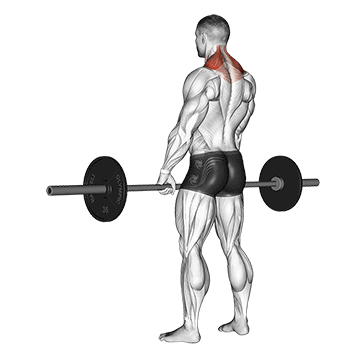You Want To Build Big Traps, Don't You? Well, You are at right place. We'll discuss about the best exercises which will help you build those big traps.
The trapezius muscle, also known as the "traps," is a large muscle that runs from the base of the skull to the middle of the back. It's responsible for movements such as shrugging the shoulders and rotating the neck. Here are some exercises that can help you build big traps:
1. Barbell Shrugs
This is one of the most effective exercises for building the traps. Stand with your feet shoulder-width apart, holding a barbell with an overhand grip. Raise your shoulders as high as you can, hold for a count of two, and then slowly lower them back down. Repeat for three sets of 8 to 12 reps.
2. Dumbbell Shrugs
This exercise is similar to barbell shrugs, but with dumbbells. Stand with your feet shoulder-width apart, holding a pair of dumbbells at your sides. Raise your shoulders as high as you can, hold for a count of two, and then slowly lower them back down. Repeat for three sets of 8 to 12 reps.
3. Upright Rows
Stand with your feet shoulder-width apart, holding a barbell in front of your body with an overhand grip. Keep your elbows high and close to your body as you raise the barbell up towards your chin. Lower the barbell back down to the starting position, and repeat for three sets of 8 to 12 reps.
4. Face Pulls
This exercise can be done using a cable machine. Stand facing the cable machine, with a rope attachment attached to the high pulley. Grasp the rope with both hands, and pull it towards your face, keeping your elbows high. Hold for a count of two, and then slowly release the rope back to the starting position. Repeat for three sets of 8 to 12 reps.
5. Dumbbell Power Cleans
This exercise works not only the traps but also the entire upper body. Start with a dumbbell in each hand, and bend your knees to lower your body into a squat position. Explosively stand up, using the momentum to raise the dumbbells to your shoulders. Lower the dumbbells back down to the starting position, and repeat for three sets of 8 to 12 reps.
Incorporating these exercises into your workout routine can help you build bigger traps. Remember to always use proper form and start with lighter weights before gradually increasing the weight. Make sure to also stretch your traps after your workout to help prevent injury.
It is important to remember that building big traps takes time and consistent effort. Incorporating these exercises into your routine along with a balanced diet and enough rest and recovery can help you achieve your goals.
When exercising the trapezius muscle (or "traps"), it's important to keep the following points in mind:
Form: Maintain proper form while performing each exercise to avoid injury and ensure that you're targeting the right muscle group. Keep your back straight and avoid swinging the weight or using momentum to complete reps.
Warm-up: Always warm-up before starting your workout to prepare your muscles and reduce the risk of injury. This can include light cardio, dynamic stretching, or foam rolling.
Weight: Start with lighter weights and gradually increase as you get stronger. Don't overdo it or try to lift too much weight too soon.
Repetitions: Aim for 8 to 12 reps per set for each exercise. This will help build muscle and increase strength.
Sets: Complete 3 to 4 sets of each exercise to adequately target the traps.
Recovery: Give your muscles adequate time to recover between workouts. This will help prevent injury and allow your muscles to grow.
Balance: Don't neglect other muscle groups and include exercises for your upper back, neck, and shoulders to maintain balance and prevent injury.
Hydration: Stay hydrated before, during, and after your workout. This will help you perform at your best and speed up recovery.
Focus: Pay attention to the muscle you're working and focus on contracting it during each exercise. This will help you get the most out of your workout.
Following these guidelines while exercising your traps can help you achieve your goals while minimizing the risk of injury. As always, it's best to consult with a doctor or a qualified fitness professional before starting any new exercise routine.






Comments
Post a Comment